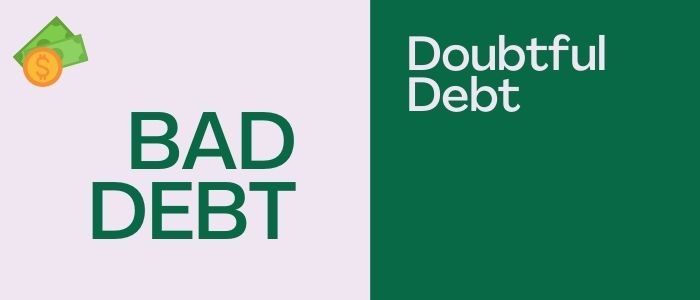Difference between Bad Debt and Doubtful Debt
What is a bad debt?
Bad debt is a loan that has become worthless. Bad debts can occur as a result of a business decision or from outside circumstances, such as illness or death of the borrower.
A lender may accept this loss by writing off the entire amount of money owed to them on their income tax return. Bad debts are considered to be uncollectible. Therefore, no matter how hard you try or what strategies you use, there is no way that the money can be collected.
What are doubtful debts?
A doubtful debt is one for which there is some doubt as to whether or not the full amount will be collected. You may consider a doubtful debt as being almost worthless, but it still has some value.
A doubtful debt can be recovered if a borrower makes payments or repays the loan in full. However, you will have to change your business practices and procedures in order to collect this money.
Bad Debts vs Doubtful Debts: What are the differences?
- Bad debt is an uncollectible loan.
- A doubtful debt is one for which there are doubts as to whether or not the full amount will be collected. However, a doubtful debt can become a bad debt if it is no longer collectible and has gone into default status.
- A doubtful debt can be recovered if a borrower makes payments or repays the loan in full. But a bad debt is considered to be uncollectible.
- The difference between a doubtful debt and bad debt is that the former can be recovered as long as you make some changes in your business practices and procedures while the latter cannot be collected even if you try every possible way to collect it.
- Bad debt is an uncollectible loan that has become worthless because of unforeseen circumstances, such as death or prolonged illness of the borrower. It is not possible to get this money back even if you try every possible way to collect it.
- If a business makes loans to its customers, the money lent to them is considered a bad debt if they do not pay back.
- You can take a deduction for bad debts on your income tax return if you made a loan and it became worthless because of certain circumstances, such as death or prolonged illness of the borrower.
These are some of the important differences between bad debts and doubtful debts. To be able to understand it better, let’s look at some examples.
Bad Debt Example: A Bad Loan John has a bad credit score and can’t get any loans from regular lending sources. He then applies to the bank for a loan and is approved for $5000 with an interest rate of 10% per year. He takes this money and invests it in a business venture.
However, his investment does not fare well and he is unable to pay back the loan on time. The bank then sends him a letter saying that he has missed three consecutive payments and if he misses another payment, they will consider his loan to be in default. John then files for bankruptcy and is no longer able to pay back the loan.
The bank writes off the loan as a bad debt so that it can deduct this amount from its income tax return if required.
In this example, John’s loan was considered bad debt because he was unable to pay back the loan even after he invested his money in a business venture.
Doubtful Debt Example: A Doubtful Loan Jim owns a business and lends $1000 to one of his employees. The employee is not sure whether or not he will be able to pay the money back because of his bad credit score, so Jim decides that it would be best if he lent him a smaller amount.
However, Jim is not able to recover the amount even after several months and decides that it is no longer worth trying to get this money back. In this example, not all of the $1000 was considered bad debt because Jim had some hope that he would be able to collect at least most of his loan. However, since he did not recover it, the amount is considered a doubtful debt for tax purposes.
